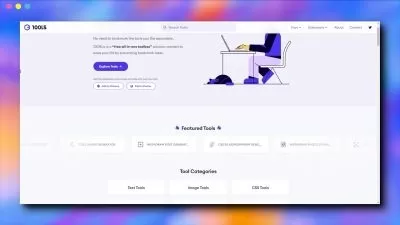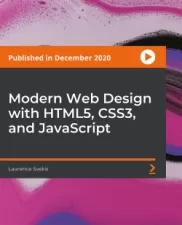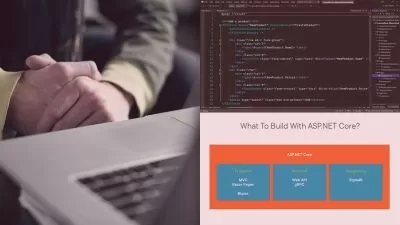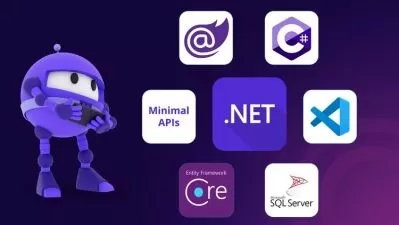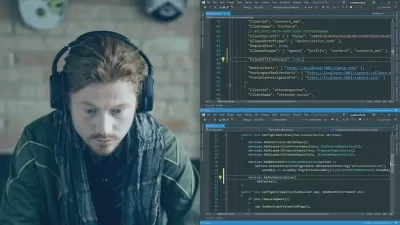Blazor and Web Development Fundamentals with .Net 7
Irlon Terblanche
2:43:57
Description
Learn the underlying mechanics of Blazor Server, WebAssembly and Progressive Web Applications with minimal coding skills
What You'll Learn?
- Essential foundations and underlying mechanics of Blazor Web Applications
- Essential differences between Blazor WASM, Blazor Server and Blazor PWAs
- Microsoft's .Net7 Framework and how it supports Blazor Applications
- WebAssembly technology and how it supports web application development
- Technical fundamentals of web client/browser and server communications
- Signal R, the Document Object Model (DOM) and RenderTree concepts
- PWA manifest and service-worker concepts
Who is this for?
More details
DescriptionIn this course, you will learn the important underlying mechanics of all the different types of Blazor web applications. You will not have to write a single line of code to get through this course.
I am specifically steering away from jumping into the code, because without understanding the subtle differences between the different Blazor applications, you will end up 'coding in the dark', and you will get into issues for which there is not much support for currently. For example, if you don't understand the detailed mechanics of Blazor applications, you will not understand why you are getting CORS errors when making HTTPÂ calls from your Blazor WASM application, or why you are getting database concurrency issues with Blazor Server and EF Core. And so on...
The course is divided into 5 parts. The first two parts of this course will focus on the theory of Blazor. In Parts 3 to 5, we will see those theoretical concepts from Parts 1 and 2 in action.
In Part 1, I will discuss what Blazor is, what the different types of Blazor applications are, and how the different hosting options work. I will also go into some detail about Single Page Applications and WebAssembly technology.
In Part 2, I will cover the .Net7 Framework, the Document Object Model, and the Render Tree concepts.
In Part 3, we will start getting more hands-on. We will create and run both Blazor Server and Blazor WASM applications from within Visual Studio. We will also start comparing the two application types in Part 3.
In Part 4, we will go into more detail with both Server and WASM applications. There will be a big focus on the runtime differences, which we'll explore using our browser developer tools.
Then finally, in Part 5, we'll create, run and install Blazor Progressive Web Applications (PWAs) onto our local machines. We will create 2 types of PWAs - a stand-alone PWA and an ASP(.)NetCore Hosted Application. We'll conclude Part 5 with some closing remarks about why PWAs are not always the best option for your use case, and what complications come with the development and testing of PWAs.
Who this course is for:
- This course is for full-stack development beginners, who want strong foundations for Blazor web application development.
- This course is not for experienced developers, unless they want to revisit fundamental concepts that we all tend to forget as we continue on our coding journey.
- It is intended to help beginners to get up to speed as fast as possible in their web development journey.
In this course, you will learn the important underlying mechanics of all the different types of Blazor web applications. You will not have to write a single line of code to get through this course.
I am specifically steering away from jumping into the code, because without understanding the subtle differences between the different Blazor applications, you will end up 'coding in the dark', and you will get into issues for which there is not much support for currently. For example, if you don't understand the detailed mechanics of Blazor applications, you will not understand why you are getting CORS errors when making HTTPÂ calls from your Blazor WASM application, or why you are getting database concurrency issues with Blazor Server and EF Core. And so on...
The course is divided into 5 parts. The first two parts of this course will focus on the theory of Blazor. In Parts 3 to 5, we will see those theoretical concepts from Parts 1 and 2 in action.
In Part 1, I will discuss what Blazor is, what the different types of Blazor applications are, and how the different hosting options work. I will also go into some detail about Single Page Applications and WebAssembly technology.
In Part 2, I will cover the .Net7 Framework, the Document Object Model, and the Render Tree concepts.
In Part 3, we will start getting more hands-on. We will create and run both Blazor Server and Blazor WASM applications from within Visual Studio. We will also start comparing the two application types in Part 3.
In Part 4, we will go into more detail with both Server and WASM applications. There will be a big focus on the runtime differences, which we'll explore using our browser developer tools.
Then finally, in Part 5, we'll create, run and install Blazor Progressive Web Applications (PWAs) onto our local machines. We will create 2 types of PWAs - a stand-alone PWA and an ASP(.)NetCore Hosted Application. We'll conclude Part 5 with some closing remarks about why PWAs are not always the best option for your use case, and what complications come with the development and testing of PWAs.
Who this course is for:
- This course is for full-stack development beginners, who want strong foundations for Blazor web application development.
- This course is not for experienced developers, unless they want to revisit fundamental concepts that we all tend to forget as we continue on our coding journey.
- It is intended to help beginners to get up to speed as fast as possible in their web development journey.
User Reviews
Rating
Irlon Terblanche
Instructor's Courses
Udemy
View courses Udemy- language english
- Training sessions 31
- duration 2:43:57
- Release Date 2023/03/05






